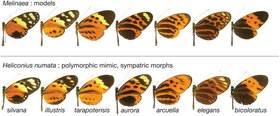Mimicry can often be observed in nature, and several types can be discerned. One of these types is known as Müllerian mimicry (named after the German zoologist Johann Friedrich Theodor Müller), or when two or more harmful species copy each other’s warning signals. This type of mimicry is well-known among unpalatable butterflies.
The question, however, is, how do they do this?
In the hope of elucidating the matter somewhat, researchers from the Centre Nationale de la Reserche Scientifique (at the National History Museum in Paris), and the University of Exeter, have set out to study the Amazonian butterfly species Heliconius numata, or the Numata Longwing, a mimic that can copy several other species of untasty butterflies. So, one population of this butterfly can feature many different wing patterns, each one copying another species.
The wing pattern of this butterfly is controlled by a single chromosomal region, containing a cluster of several genes that control different aspects of the wing pattern. Such clustered genes are also known as ‘supergenes’. Several complex patterns in nature are controlled by supergenes, such as the shape of primrose flowers and the pattern of snail shells.
The researchers found that, in this butterfly species, three versions of the same chromosome coexist, each controlling different patterns of wing coloration. This means that butterflies carrying the same DNA can look completely different (see figure 1).

Figure 1: Polymorphic forms of H. numata (top) mimic different models in the distantly related genus Melinaea (bottom).
(Source: Joron et al., 2011)
In the words of the authors:
Our results indicate that allelic combinations at known wing-patterning loci have become locked together in a polymorphic rearrangement at the P locus, forming a supergene that acts as a simple switch between complex adaptive phenotypes found in sympatry.
This supergene also turns out to be quite important in melanism in other species, such as the famous Peppered moth, or Biston betularia (see figure 2), that developed black wings in the sooty environment of nineteenth-century Britain.

Figure 2: Dark and light forms of B. betularia.
(Source: bbc.co.uk)
One of the authors said:
This supergene region not only allows insects to mimic each other, as in Heliconius, but also to mimic the soot blackened background of the industrial revolution -- it's a gene that really packs an evolutionary punch.
Edit (18 August 2011): Today, I ran across this video which explains the study quite well.
Video: Supergene controls butterfly mimicry.
(Source: NatureVideoChannel)
References
Joron, M.; Frezal, L.; Jones, R.T.; Chamberlain, N.L.; Lee, S.F.; Haag, C.R.; Whibley, A.; Becuwe, M.; Baxter,S.W.; Ferguson, L.; Wilkinson, P.A.; Salazar, C.; Davidson, C.; Clark, R.; Quail, M.A.; Beasley, H.; Glithero, R.; Lloyd, C.; Sims, S.; Jones, M.C.; Rogers, J.; Jiggins, C.D. and ffrench-Constant, R.H. (2011). Chromosomal rearrangements maintain a polymorphic supergene controlling butterfly mimicry. Nature. Published online August 14, 2011. doi:10.1038/nature10341.
University of Exeter, Featured News.
Van ‘t Hof, A.E.; Edmonds, N.; Dalíková, M.; Marec, F. and Saccheri, I.J. (2011). Industrial Melanism in British Peppered Moth Has a Singular and Recent Mutational Origin. Science. 332(6032), pp. 958 – 960. doi:10.1126/science.1203043.




Comments